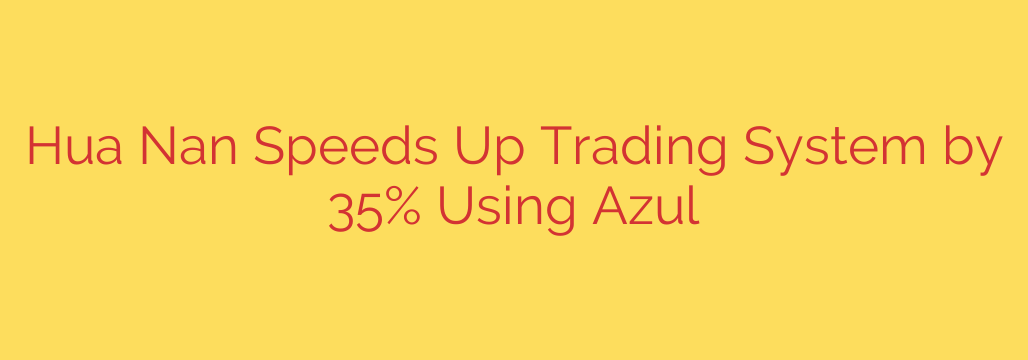
Unlocking Peak Performance in Financial Trading: The Battle Against Latency
In the world of electronic trading, success is measured in microseconds. Every fraction of a second can mean the difference between a profitable trade and a missed opportunity. For financial institutions, the speed and reliability of their trading platforms are not just technical metrics—they are a core competitive advantage. However, many firms running on powerful Java-based systems face a hidden performance killer: latency.
This challenge isn’t about the raw speed of the code but about consistency. High-frequency trading (HFT) and other electronic systems demand predictable, ultra-low latency. Yet, standard Java platforms can introduce sudden, unpredictable pauses that grind operations to a halt at the worst possible moments, like during peak market volatility.
The Hidden Bottleneck: Understanding Garbage Collection Pauses
Many high-performance trading applications are built on Java, prized for its robust ecosystem and developer productivity. However, the standard Java Virtual Machine (JVM) has an Achilles’ heel for this use case: garbage collection (GC). GC is an essential process that automatically reclaims memory, preventing system crashes. But for it to work, traditional JVMs must periodically “stop the world”—pausing the entire application for a moment to clean up.
While these pauses are often brief and unnoticeable in most applications, they are catastrophic in financial trading. A pause of even a few milliseconds can lead to:
- Delayed order executions
- Inaccurate pricing data
- Lost trading opportunities
- A degraded quality of service for clients
For one leading securities firm, this problem became a critical business obstacle. Their electronic trading system, while generally powerful, suffered from unpredictable latency spikes during crucial trading hours, such as market open and close. These performance bottlenecks were traced directly to the JVM’s garbage collection process, creating unacceptable delays and putting the firm at a disadvantage.
The Solution: A Breakthrough in Java Performance
Rather than undertaking a costly and time-consuming redevelopment of their entire platform, the firm focused on optimizing its foundation. They replaced their standard JVM with a specialized, high-performance Java platform designed specifically for low-latency environments.
The results were immediate and transformative. By implementing an advanced JVM with a pauseless garbage collector, the firm achieved:
- A remarkable 35% increase in transaction processing speed.
- The complete elimination of performance outliers and latency spikes previously caused by garbage collection.
- Consistent, predictable performance even during the most intense periods of market activity.
This strategic upgrade allowed the system to handle a higher volume of transactions with greater speed and reliability. The firm was not only able to fix its performance issues but also gain a significant competitive edge in the fast-paced securities market.
The Business Impact of Eliminating Latency
Optimizing a trading system’s underlying platform is more than just a technical fix; it’s a strategic business decision. The primary benefits include:
- Faster and More Reliable Trade Execution for Clients: Delivering better and more consistent execution builds client trust and attracts more business.
- Increased System Capacity: A more efficient platform can process more transactions without requiring expensive hardware overhauls, allowing for scalable growth.
- Enhanced Competitiveness: In a market where speed is everything, a consistently faster platform is a powerful differentiator that enables firms to capitalize on market opportunities more effectively.
Actionable Advice for Optimizing Your Trading Platform
For financial institutions and fintech companies looking to enhance their own Java-based systems, this success story offers a clear roadmap.
- Benchmark Your Latency: First, you must measure what you want to improve. Use monitoring tools to identify the frequency and duration of latency spikes in your application, especially during peak loads.
- Isolate the Root Cause: Determine if these pauses are caused by network issues, inefficient code, or the JVM’s garbage collection process. Profiling tools can help pinpoint the source of the bottleneck.
- Evaluate Specialized Infrastructure: Standard, general-purpose tools are not always sufficient for extreme performance requirements. Investigate specialized JVMs and other infrastructure components designed for ultra-low latency workloads.
- Prioritize Predictability Over Peak Speed: While high average speed is good, consistent and predictable performance is even better. Eliminating the outliers—the sudden pauses—is often the key to building a truly reliable and competitive trading system.
In today’s hyper-competitive financial markets, the underlying technology stack is a critical component of success. By addressing foundational issues like Java latency, firms can unlock new levels of performance, ensure system reliability, and deliver superior results for their clients.
Source: https://datacenternews.asia/story/hua-nan-boosts-trading-system-speed-by-35-with-azul-switch








